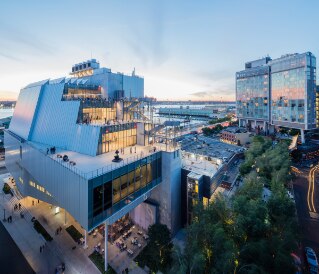The career of Paul Rudolph (1918-1997) follows quite an unfortunate trajectory. His rise is tremendous, projecting him from his modest background (as the son of a reverend from Kentucky) to the role of chair of Yale University’s School of Architecture, since 1958, and the designer of its famous building (1958-1964). His decline is just as rapid, starting from approximately a decade later. The most powerful of American architects sees its commissions rapidly shrink, for an ill-fated combination of taste evolution – the emergence of postmodern and historicist sensitivities gives a tough coup de vieux to his brutalist-oriented research – and biographic complications – his homosexuality, well-known but still in the closet, is exploited to make him an outsider.
Domus shows quite an inconstant interest for Rudolph’s work. Almost all the articles about him date to a short period between 1970 and 1977. More interestingly, on many occasions editors openly admit their struggle between an actual curiosity and a just as deep suspicion for his architectural and urban visions.
Agnoldomenico Pica, for instance, shares his concerns in his review of an important monography about Rudolph from 1970, prefaced by Sibyl Moholy-Nagy (Domus 493, December 1970). He comments in particular on the unrealized project from 1967 for New York’s Graphic Arts Center. He is impressed by an architecture functioning “at the topographic scale, rather than at the scale of construction (…). An architecture that doesn’t modify landscape but rather invents it; that doesn’t highlight topographic features, but rather build them from scratch”. And yet, a few criticalities of what he calls “a giant termite mound” doesn’t elude him. “Its main issues” he explains “might stem not as much from the relationship between megastructure and microorganisms (the cells), as from its urban implications, which are likely to be negative; not to mention the plastic, or better plastic-scenographic results, which appear anything but reassuring”.
With the necessary caveats, these considerations can be applied also to the “seven huge intercommunicating residential units” of his proposal for the Buffalo Waterfront Development, quickly mentioned on Domus 494, January 1971, and more importantly to his extraordinary study for the Lower Manhattan Expressway, from 1972 but published on Domus 558, May 1976. Commissioned by the Ford Foundation, Rudolph imagines a megastructure that amplifies the trace of the new urban highway and projects it in the third dimension. Along its path stretches an entire multifunctional city, crossed in multiple directions by car flows, as well as by buses, elevators, escalators, treadmills, technical installations and pipes.
The Lower Manhattan Expressway is a mountain chain, elevated on the island’s gently sloping surface. While in 1811 the Commissioners’ Plan’s grid had tried to flatten it to an undifferentiated plan, Rudolph revamps it by the superimposition of a thick backbone, a re-founding act of both its natural morphology and of the abstract masterplan. Domus acknowledges that it fails for The discrete charm of utopia, but it doesn’t spare its criticism to an approach with is already outdated at the time: “In this age of worldwide crisis, there are still architects that, beyond good and evil, and to their own expenses, keep believing that the issues of societies and territories can be solved through architecture (…). But it’s society that has to reinvent itself first, and afterward it can choose the structure, urban or not urban, where it wishes to settle”. Incidentally, the same reasoning is applied to two projects for the Po Valley megalopolis by Lombard “megastructurist” Carlo Moretti, a regular presence on the magazine’s pages at the time.
Seen from a contemporary perspective, from a moment when urban design is finding a new legitimation thanks to an ever more participated and tactic approach, Rudolph’s experiments of urban engineering look like the disturbing outcomes of a centralized, entirely top-down form of planning. Involved in the widespread brutalist revival, his completed buildings deserve separate consideration, as is the case for his interiors.
Domus features the core of what would later become his much talked-about Manhattan penthouse (Domus 575, October 1977), and another less known but just as surprising realization, the New York flat for a former college friend (Domus 502, settembre 1971). The apartment is designed “as if it was to host a party”. The living room is entirely white; floor, cushions and seat-islands are upholstered with the same fur; one hundred eleven bulbs drop from the ceiling to the floor, following the four walls; above the fireplace are giant projections of the exact time (…). In the dining room, the high point of the party, walls and chairs are covered in silver plastic; the table top is a thin iron grid (the one that is used for metro stations flooring), filled by little mirror rectangles at regular distance, and protected by a sheet of glass; the window curtain is made of the same mirror rectangles (…). The white bedroom features six rotating cylinder-closets, that are actually cardboard formworks (sonotubes) employed by the USA’s construction industry for concrete pillars”.
While he is already experiencing a downward trend, Rudolph seeks shelter from the metropolitan scale to the dimension of the house. Here, he introduces materials, textures and devices that are typical of the city and of the field of heavy construction. He reassembles them in a kaleidoscopic domestic space, hedonist rather than comfortable, more challenging than practical. In doing so, he shows a clear kinship, both conceptual and formal, to the experiments of some Italian designers of the time, such as Nanda Vigo, who was then setting up radical houses that were Blue (1967-1972), Black (1970), and Yellow (1970).
While on an aesthetical plan Rudolph’s interiors are just as vintage as his highways, the message they bear is still topical. Rudolph’s houses, much as Vigo’s, are the image and the stage of lives lived out-of-the-box. Their self-satisfied exaggerations are an invitation to constantly renovate our view on the domestic space, to turn it into an experimentation field for personal tastes and habits, against the idleness of standardized solutions and the conformism of good taste.










